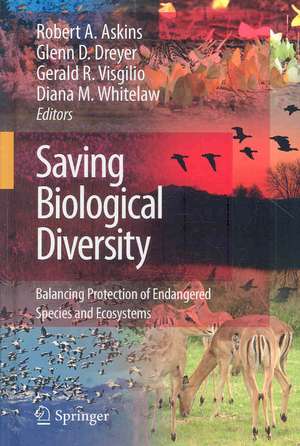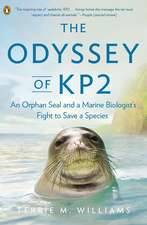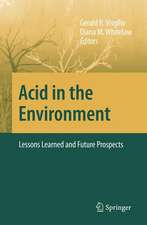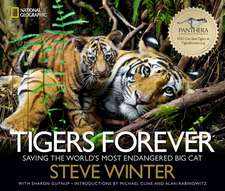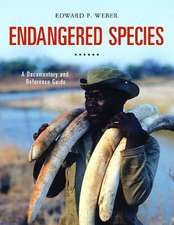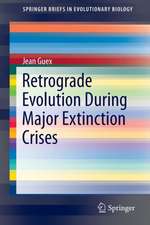Saving Biological Diversity: Balancing Protection of Endangered Species and Ecosystems
Editat de Robert A. Askins, Glenn D. Dreyer, Gerald R. Visgilio, Diana M. Whitelawen Limba Engleză Hardback – 29 sep 2008
| Toate formatele și edițiile | Preț | Express |
|---|---|---|
| Paperback (1) | 869.87 lei 6-8 săpt. | |
| Springer Us – 29 oct 2010 | 869.87 lei 6-8 săpt. | |
| Hardback (1) | 631.27 lei 6-8 săpt. | |
| Springer Us – 29 sep 2008 | 631.27 lei 6-8 săpt. |
Preț: 631.27 lei
Preț vechi: 742.68 lei
-15% Nou
Puncte Express: 947
Preț estimativ în valută:
120.85€ • 125.62$ • 100.20£
120.85€ • 125.62$ • 100.20£
Carte tipărită la comandă
Livrare economică 06-20 februarie 25
Preluare comenzi: 021 569.72.76
Specificații
ISBN-13: 9780387095660
ISBN-10: 0387095667
Pagini: 228
Ilustrații: XVIII, 228 p.
Dimensiuni: 156 x 235 x 16 mm
Greutate: 0.53 kg
Ediția:2008
Editura: Springer Us
Colecția Springer
Locul publicării:New York, NY, United States
ISBN-10: 0387095667
Pagini: 228
Ilustrații: XVIII, 228 p.
Dimensiuni: 156 x 235 x 16 mm
Greutate: 0.53 kg
Ediția:2008
Editura: Springer Us
Colecția Springer
Locul publicării:New York, NY, United States
Public țintă
ResearchCuprins
Saving Biological Diversity: An Overview.- Saving Biological Diversity: An Overview.- Protecting Populations of Particular Species.- Toward a Policy-Relevant Definition of Biodiversity.- Navigating for Noah: Setting New Directions for Endangered Species Protection in the 21st Century.- Economics of Protecting Endangered Species.- The Center for Plant Conservation: Twenty Years of Recovering America’s Vanishing Flora.- The Piping Plover as an Umbrella Species for the Barrier Beach Ecosystem.- Restoring Atlantic Salmon (Salmo salar) to New England.- Protecting Regional Ecosystems.- Sea Change: Changing Management to Protect Ocean Ecosystems.- Valuing Benefits from Ecosystem Improvements using Stated Preference Methods: An Example from Reducing Acidification in the Adirondacks Park.- Conserving Forest Ecosystems: Guidelines for Size, Condition and Landscape Requirements.- Restoring America’s Everglades: A Lobbyist’s Perspective.- The Need For Global Efforts To Save Biological Diversity.- A Wildland and Woodland Vision for the New England Landscape: Local Conservation, Biodiversity and the Global Environment.- Creative Approaches to Preserving Biodiversity in Brazil and the Amazon.- Anthropogenic Carbon Dioxide Emissions and Ocean Acidification: The Potential Impacts on Ocean Biodiversity.- Advancing Conservation in a Globalized World.- Protecting Biodiversity, from Flagship Species to the Global Environment.
Notă biografică
Robert Askins is Professor of Biology at Connecticut College, where he teaches courses in ecology, environmental studies, animal behavior, and ornithology. His research focuses on the ecology and conservation of migratory birds in both their northern breeding areas and tropical wintering areas. He has analyzed the habitat requirements of forest birds that nest in deciduous forests in New England and Japan, and the ecology of songbirds that spend the winter in the U.S. Virgin Islands. He also has studied species that are restricted to early successional forest habitats. He has published scientific papers in numerous journals including Science, Proceedings of the National Academy of Sciences, Wetlands, Ecology, Current Ornithology, Studies in Avian Biology, Wilson Bulletin, and Conservation Biology. In 2000 he published "Restoring North America’s Birds; Lessons from Landscape Ecology," a book on the ecology and conservation of North American birds. Currently he is chair of the Biology Department at Connecticut College and Karla Heurich Harrison Director of the Goodwin-Niering Center for Conservation Biology and Environmental Studies.
Glenn D. Dreyer is the Charles & Sarah P. Becker ‘27 Director of the Connecticut College Arboretum and an Adjunct Associate Professor of Botany at Connecticut College. His career has focused primarily on the interface between horticulture and ecology from both academic and management perspectives. The Connecticut College Arboretum has historically operated as both public garden featuring native plants and as an ecological field site for research and teaching. Dreyer’s research has focused mainly on the ecology and control of invasives, vegetation management, and documenting big and historic trees. He also serves as Executive Director of the Goodwin-Niering Center.
Gerald R. Visgilio is Professor of Economics at Connecticut College, where he has spent nearly three decadesworking in the area of environmental and natural resource economics. He teaches courses in microeconomics, environmental and natural resource economics, law and economics, and antitrust economics and policy. His current research focuses on an economic evaluation of emission control policies. He has co-edited three books: Our Backyard A Quest for Environmental Justice, which was listed by Choice among its Outstanding Academic Titles in 2003, America’s Changing Coasts Private Rights and Public Trust, which was included in Edward Elgar’s Advances in Ecological Economics series in 2005, and Acid in the Environment Lessons Learned and Future Prospects, which was recently published in 2007. He also is on the faculty of the Goodwin-Niering Center.
Diana M. Whitelaw is Associate Director of the Goodwin-Niering Center for Conservation Biology and Environmental Studies at Connecticut College where she coordinates the Certificate Program in Environmental Studies. Whitelaw co-edited Our Backyard: A Quest for Environmental Justice, which was selected by Choice as an Outstanding Academic Title in Science and Technology in 2003, America’s Changing Coasts: Private Rights and Public Trust in 2005 and Acid in the Environment: Lessons Learned and Future Prospects in 2007.
Glenn D. Dreyer is the Charles & Sarah P. Becker ‘27 Director of the Connecticut College Arboretum and an Adjunct Associate Professor of Botany at Connecticut College. His career has focused primarily on the interface between horticulture and ecology from both academic and management perspectives. The Connecticut College Arboretum has historically operated as both public garden featuring native plants and as an ecological field site for research and teaching. Dreyer’s research has focused mainly on the ecology and control of invasives, vegetation management, and documenting big and historic trees. He also serves as Executive Director of the Goodwin-Niering Center.
Gerald R. Visgilio is Professor of Economics at Connecticut College, where he has spent nearly three decadesworking in the area of environmental and natural resource economics. He teaches courses in microeconomics, environmental and natural resource economics, law and economics, and antitrust economics and policy. His current research focuses on an economic evaluation of emission control policies. He has co-edited three books: Our Backyard A Quest for Environmental Justice, which was listed by Choice among its Outstanding Academic Titles in 2003, America’s Changing Coasts Private Rights and Public Trust, which was included in Edward Elgar’s Advances in Ecological Economics series in 2005, and Acid in the Environment Lessons Learned and Future Prospects, which was recently published in 2007. He also is on the faculty of the Goodwin-Niering Center.
Diana M. Whitelaw is Associate Director of the Goodwin-Niering Center for Conservation Biology and Environmental Studies at Connecticut College where she coordinates the Certificate Program in Environmental Studies. Whitelaw co-edited Our Backyard: A Quest for Environmental Justice, which was selected by Choice as an Outstanding Academic Title in Science and Technology in 2003, America’s Changing Coasts: Private Rights and Public Trust in 2005 and Acid in the Environment: Lessons Learned and Future Prospects in 2007.
Textul de pe ultima copertă
The distinctive contribution of this book is that it presents a pragmatic approach for preserving biological diversity. Experts in a wide variety of fields, including philosophy, environmental policy, law, economics and biology, present different perspectives on how to prevent widespread extinction around the world. Several chapters deal with basic questions such as how we should define biodiversity and how we should determine what is most important to save. Two chapters focus on how we can place an economic value on biological diversity, a step that is often critical for gaining acceptance for conservation efforts. One of the major conclusions is that people are often willing to pay to preserve natural systems that have no immediate value in terms of generating income or commodities. Other chapters are case studies of efforts to protect particular species or ecosystems; these provide practical guidelines for how to protect biodiversity more effectively.
The book is divided into three sections: we start with discussions of efforts to protect endangered species; move to approaches for protecting intact, functioning natural ecosystems; and finish with proposals to protect the global natural system (the biosphere). It becomes clear as one progresses through these sections that these three approaches do not constitute distinctly different, much less competing, strategies for protecting biological diversity. Instead they are interdependent. Efforts to protect a particular endangered species typically lead to efforts to protect its ecosystem. Similarly, efforts to protect an ecosystem lead naturally to concerns about the atmosphere, climate and water supplies. The interdependence may also work in the other direction: loss of species potentially can undermine the stability and resilience of ecosystems, which can have a large negative impact on the biosphere. The main conclusion is that a wide range of approaches to conservation is needed to maintain diverse and ecologically functioning natural systems.
The book is divided into three sections: we start with discussions of efforts to protect endangered species; move to approaches for protecting intact, functioning natural ecosystems; and finish with proposals to protect the global natural system (the biosphere). It becomes clear as one progresses through these sections that these three approaches do not constitute distinctly different, much less competing, strategies for protecting biological diversity. Instead they are interdependent. Efforts to protect a particular endangered species typically lead to efforts to protect its ecosystem. Similarly, efforts to protect an ecosystem lead naturally to concerns about the atmosphere, climate and water supplies. The interdependence may also work in the other direction: loss of species potentially can undermine the stability and resilience of ecosystems, which can have a large negative impact on the biosphere. The main conclusion is that a wide range of approaches to conservation is needed to maintain diverse and ecologically functioning natural systems.
Caracteristici
Truly multidisciplinary approach – Each of the three sections of the book (on endangered species, ecosystems and global environmental problems) includes chapters by people with very different backgrounds and perspectives in fields such as ecology, conservation, philosophy, law, economics and policy. Both researchers and managers/conservationists have contributed their points of view. Accessible to general readers – The contributors were asked to write chapters that are accessible to a non-specialist, and the chapters were carefully edited to remove (when possible) or define (when necessary) specialist jargon, regardless of whether it came from economics, biology, law or political science. The distinctive styles and analytical approaches of different disciplines still come through, but a general reader should be able to understand the concepts in any chapter. Facilitates comparison and synthesis by the reader – Although Robert Askins attempts to summarize the major conclusions of this book in a final chapter, readers will discover their own connections and conclusions as they read about the same basic issue from many perspectives. Use as a textbook - Because this book is accessible and will trigger interesting ideas and discussions, it would be an excellent text to use for supplemental reading in a conservation biology or ecology course, or as one of the main readings in a seminar course.
